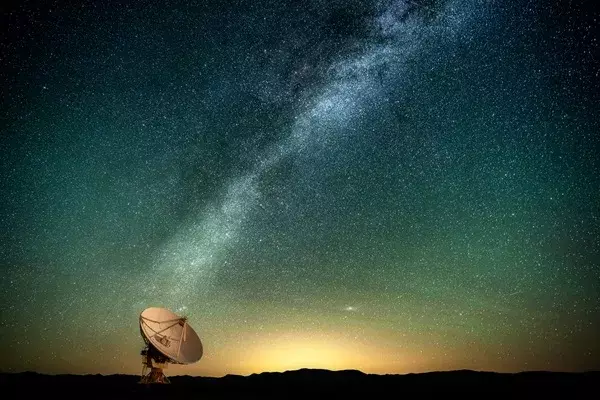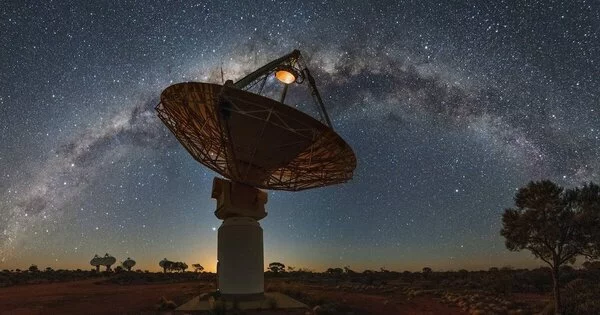Fast radio bursts are still one of the most exciting and puzzling astronomical phenomena. They are short, strong bursts of radio waves that originate in faraway galaxies and last barely a few milliseconds. Despite multiple detections, the precise cause and origin of FRBs has remained mostly unknown.
An international team reports on a radio pulsar phase of a Galactic magnetar that generated a rapid radio burst in 2020; data show distinct origins for ‘bursts’ and ‘pulses,’ adding to the idea of FRB generation.
More than 15 years after the discovery of fast radio bursts (FRBs), which are millisecond-long cosmic explosions of electromagnetic radiation in deep space, scientists around the world have been scanning the universe for clues about how and why they arise.
Almost all identified FRBs originated in distant space outside our Milky Way galaxy. That is, until April 2020, when FRB 20200428, the first Galactic FRB, was discovered. This FRB was created by a magnetar (SGR J1935+2154), which is a compact, city-sized neutron star with a massive magnetic field.
FAST detected 795 pulses in 16.5 hours over 13 days from the source. These pulses show different observational properties than the bursts observed from the source.
Weiwei Zhu
This ground-breaking discovery led others to speculate that FRBs detected at cosmic distances beyond our galaxy could be created by magnetars as well. However, the smoking gun for such a situation, a rotation period caused by the magnetar’s spin, has so far eluded detection. A new study of SGR J1935+2154 provides insight on this strange disparity.
An international team of scientists, including UNLV astrophysicist Bing Zhang, report on the continued monitoring of SGR J1935+2154 following the April 2020 FRB, as well as the discovery of another cosmological phenomenon known as a radio pulsar phase five months later, in the July 28 issue of the journal Science Advances.

Unraveling a Cosmological Conundrum
Astronomers use large radio telescopes like China’s huge Five-hundred-meter Aperture Spherical radio Telescope (FAST) to track FRBs and other deep-space phenomena in their quest for answers. Using FAST, astronomers discovered that FRB 20200428 and the later pulsar phase emanated from separate places within the magnetar’s sweep, pointing to different origins.
“FAST detected 795 pulses in 16.5 hours over 13 days from the source,” said Weiwei Zhu, the paper’s principal author from the National Astronomical Observatory of China (NAOC). “These pulses show different observational properties than the bursts observed from the source.”
This dichotomy in emission modes from the region of a magnetosphere helps astronomers understand how – and where – FRBs and related phenomena occur within our galaxy and perhaps also those at further cosmological distances.
Radio pulses are cosmic electromagnetic explosions akin to FRBs, although their brightness is typically 10 orders of magnitude lower. Pulses are often observed in revolving neutron stars known as pulsars rather than magnetars. Most magnetars, according to Zhang, a corresponding author on the paper and the director of the Nevada Centre for Astrophysics, do not release radio pulses most of the time, most likely due to their extraordinarily strong magnetic fields. However, as with SGR J1935+2154, some of them undergo exploding and become transient radio pulsars.
Another distinction between bursts and pulses is their emission “phases,” or the time window during which radio emission is emitted during each period of emission.
“Magnetar pulses, like radio pulsar pulses, are emitted within a narrow phase window within the period,” Zhang explained. “This is the well-known ‘lighthouse’ effect, in which the emission beam sweeps the line of sight only once per period and only for a short time interval in each period.” The pulsed radio emission can then be observed.”
According to Zhang, the April 2020 FRB and numerous other, less intense bursts were released in random phases outside of the pulsar phase. “This strongly suggests that pulses and bursts originate from different locations within the magnetar magnetosphere, suggesting possibly different emission mechanisms between pulses and bursts,” he says.
Implications for Cosmological FRBs
A comprehensive observation of a Galactic FRB source gives light on the enigmatic FRBs that exist at cosmic distances. Many cosmological FRBs (those that occur outside our galaxy) have been observed to repeat. FAST has detected thousands of repeated bursts from a few sources in some cases. Deep searches for seconds-level periodicity have already been conducted utilising these bursts, but no period has been detected.
According to Zhang, this casts doubt on the popular idea that repeating FRBs are powered by magnetars in the past. “Our discovery that bursts tend to be generated in random phases provides a natural interpretation to the non-detection of periodicity from repeating FRBs,” he said. “For unknown reasons, bursts tend to be emitted in all directions from a magnetar, making it impossible to identify periods from FRB sources.”





